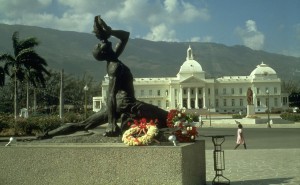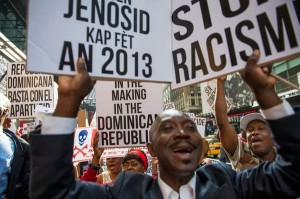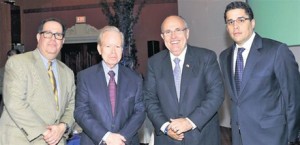The Dominican Republic is the only oppressed country that celebrates its “independence” from another oppressed, colonized country, Haiti. For generations, the fear-mongering, racist Dominican ruling class has deliberately manipulated the history of the two countries, particularly the period between 1822 and 1844, in order to perpetuate el anti-Haitianismo (anti-Haitian racism). The truth is that Haitians have never been responsible for the inequality and the dismal socio-economic conditions that exist in the Dominican Republic. Imperialism and a handful of elite families —the Vicinis, Bonettis, Barcelós, and Brugals, among others— who drape themselves in the Dominican flag and engage in a shamefaced, rhetorical admiration for Duarte, Sanchez y Mella, los padres de la patria (the fathers of the homeland)—are the true usurpers of “Dominican independence.”
The facts behind Haiti’s Unification of the Island
 The Haitian slave revolution of 1804 —overcoming seemingly insurmountable odds—was one of the great achievements recorded in human history. Hundreds of thousands of former slaves waged a popular war that defeated successive French invasions under the command of Napoleon Bonaparte (James 1938). After the former slaves, turned generals, Toussaint L’ouverture and Jean-Jacques Dessalines mobilized the Haitian people into a formidable fighting force, never again could the naysayers proclaim that revolution and the victory of the most oppressed was impossible.
The Haitian slave revolution of 1804 —overcoming seemingly insurmountable odds—was one of the great achievements recorded in human history. Hundreds of thousands of former slaves waged a popular war that defeated successive French invasions under the command of Napoleon Bonaparte (James 1938). After the former slaves, turned generals, Toussaint L’ouverture and Jean-Jacques Dessalines mobilized the Haitian people into a formidable fighting force, never again could the naysayers proclaim that revolution and the victory of the most oppressed was impossible.
Having emerged victorious from this sanguinary war of emancipation against the French, that left much of its land burnt to ashes, Haiti sought the unification of the island of Quisqueya (the Taíno name, later renamed Hispaniola, or Little Spain, by Columbus) as one fortified garrison against recolonization.
There are three incontrovertible facts about the 1822-1844 “unification:”
1) The Haitians entered into the Spanish empire’s sphere of influence—later known as the Dominican Republic—because France and the other colonial powers used this colonial outpost to threaten and re-invade Haiti in hopes of re-enslaving Haitians.
2) In 1822, Haiti liberated thousands of slaves in the Dominican Republic and sent former slave owners and landowners fleeing into exile.
3) Upon entering the eastern portion of the island, Haiti expropriated land from the all-powerful Catholic Church and the Spanish crown. This constituted land reform at the tip of “foreign” bayonets, a unique contribution from an “invading” army.
Whereas the Spanish crown built a legal system around the protection of the encomienda system, based on slavery and feudalism, the Haitians introduced a legal code that protected all persons of African and Indoamerican heritage. The Haitian constitution —revolutionary in its essence— prohibited foreigners from owning property and extended citizenship and property rights to the humblest social classes. From the point of view of the oppressed, this was the most progressive period in Dominican history (Santiago 2005). From the perspective of the encomenderos (plantation bosses), this was an unforgivable intrusion into their profit-making system (Price Mars 1953).
A Nation Divided
Though motivated by anti-colonial principles, the Haitian leadership lacked the economic means to carry out a successful unification of the two nations. Beleaguered by France’s enforcement of a “debt collection” of 150 million francs for “lost property” and facing an international blockade, the Haitian administration was unable to respond to the myriad needs of the Dominican population (Moya Pons 1977, Sagás 1994). Haitian President Jean-Pierre Boyer—overseeing 12,000 Haitian troops—faced formidable opposition from Dominican elites who desired further integration into the “global,” colonial-dominated economy.
While the long-repressed Blacks and mulattoes welcomed the arrival of an army of former slaves—as a safeguard for their own freedom—the lighter-skinned, propertied criollo class saw the “invaders” as a direct threat to their own economic interests and way of life. Led by Juan Pablo “el Patricio” Duarte, a leader inspired by the democratic ideals of burgeoning national movements in Europe, sections of the Dominican population conspired and overthrew Haitian rule in 1844 (Ferguson 1992).
The Dominican masses’ fears proved to be all too real. With the Haitians now pushed out of the scene after 1844, the privileged criollos looked to Spain to re-establish its authority and protect them and their property. The new national anthem of the separatist movement contained the verse “Rise up in arms, oh Spaniards,” hinting that this transfer of power was a counterrevolution in property relations. Seeing that its former colony was unprotected, Spain re-implemented slavery. As the word spread among the Black and mulatto population, they revolted against Spanish designs. Santiago Basora was among the newly-freed Black leaders who rebelled against the elitist separatist movement, forcing them, and their colonial overlords, to abandon the idea of reestablishing slavery in D.R. (Torres-Saillant 1998).
In 1861, when wealthy Dominican cattle-rancher and career politician Pedro Santana became the dictator of the Dominican Republic he annexed the country back to Spain, making the D.R. the only country in history to revert back to a colonial status.
The specter of a new era of Spanish colonization and slavery sparked a new nationalist resistance movement. The Black and mulatto masses —led by black General Gregorio Luperón— received support and launched guerrilla attacks from Haiti, successfully defeating the Spanish forces (Torres-Saillant, 1998).
The Centrality of History
History is contested ground. The class forces in power use their own version of history and manipulate it in order to promote myths and advance their interests. The ruling class’ “take” then becomes the accepted version of events. The Dominican nationalist version of history paints the western side of the island, Haiti, as a dark, menacing presence that seeks to “re-invade” the peaceful Dominican nation, which must protect itself at all costs. The reality is the opposite; Haitians have been the victims of Dominican state-sponsored racism, forced displacement, and massacres. In October 1937, Dominican dictator Rafael Trujillo oversaw a week-long extermination campaign along the border. Over an estimated 20,000 Haitians were murdered in the “Parsley massacre,” and thousands more were displaced.
Haitian and Dominican Solidarity
It is important to highlight the often unknown and downplayed instances of solidarity among the two nations.
As a maroon state, Haiti supported liberation movements throughout the hemisphere. They supported their one time adversary, the Dominican mulatto general, Francisco del Rosario Sanchez, against Spain’s next round of encroachments. Simón Bolívar and the anti-colonial movement in El Gran Colombia looked to Haiti for arms and support. The Venezuelan flag was sewn and first flown in Jacmel, Haiti in 1803 as Francisco de Miranda prepared his anti-colonial expedition to confront Spain. The great Cuban revolutionary José Marti set sail from Haiti when he went to fight for Cuban independence from Spain.
A century before Ernesto “Che” Guevara was born, the Haitians were the original internationalists.
The influence of the Haitian revolution was felt throughout the U.S. The southern slavocracy trembled before the idea that slaves could fight back and win. Denmark Vessey ─a slave born in the West Indies and forced to travel to the South as the assistant of a slave trader─led a historic revolt of slaves in Charlestown, North Carolina (Dunkel Haïti-Progrès September 2003). He wrote President Boyer in hopes of expanding the insurrection across the southern states.
 During periodic round-ups throughout Dominican history, many Dominican families ─risking their own lives─ have hidden Haitians who were escaping the machete and gun-wielding military. The 23-year-old poet Jacques Viaux and other Haitians fought and died alongside Dominican revolutionaries in the “constitutional war” of April 1965, resisting the invasion of 42,000 U.S. Marines sent to squash a movement for popular democracy. When Haitians were forced to flee U.S.-backed coups against the democratically elected president Jean Bertrand Aristide in 1991 and 2004, the Dominican solidarity movement received them. The Dominican Republic was the first country to respond to the 2010 earthquake that rocked Port-au-Prince. When the present Dominican government of Danilo Medina passed the law 168-13 in 2013, denying more than 200,000 Dominicans of Haitian descent citizenship, a multinational movement led by both the Dominican and Haitian communities, in the D.R. and the U.S., organized to overturn the law.
During periodic round-ups throughout Dominican history, many Dominican families ─risking their own lives─ have hidden Haitians who were escaping the machete and gun-wielding military. The 23-year-old poet Jacques Viaux and other Haitians fought and died alongside Dominican revolutionaries in the “constitutional war” of April 1965, resisting the invasion of 42,000 U.S. Marines sent to squash a movement for popular democracy. When Haitians were forced to flee U.S.-backed coups against the democratically elected president Jean Bertrand Aristide in 1991 and 2004, the Dominican solidarity movement received them. The Dominican Republic was the first country to respond to the 2010 earthquake that rocked Port-au-Prince. When the present Dominican government of Danilo Medina passed the law 168-13 in 2013, denying more than 200,000 Dominicans of Haitian descent citizenship, a multinational movement led by both the Dominican and Haitian communities, in the D.R. and the U.S., organized to overturn the law.
Towards Genuine Independence
The February 27th “independence” celebrations are a hollow charade. They are not focused on South-South solidarity or advancing Dominican workers’ interests. What plagues the Dominican Republic is not scarcity or competition with another oppressed people, but the greed and opulence of a few, in a word, capitalism.

Dominican elites meeting with Rudolph Guliani
Millions of Dominican workers pour their life blood into the main industries that make the Dominican Republic profitable for investors; sugar processing, ferronickel, gold mining, textiles, cement and tobacco. The Dominican people collectively produce over $101 billion dollars in goods and services every year (CIA World Fact Book country report 2013). From the point of view of economists —and the growth of the Gross Domestic Product— the economy is booming. Yet the average salary for a Dominican worker in these industries is a paltry $850 dollars a year! There is more than enough wealth to satisfy the needs and dreams of the 10.5 million Dominicans in D.R. and those economic migrants forced into exile abroad, including a million in a half who live in the US, over fifty thousand in Spain and tens of thousands of others who live in Puerto Rico, Venezuela, Canada and beyond. But all of the profits are siphoned off to the nation’s enemies.
The world’s leading gold-mining company, the Barrick Gold Corporation, has billions of dollars invested in extracting gold, nickel and other valuable metals. Franklin Sports, Fruit of the Loom and Adidas owned Dick’s Sporting Goods are among the largest exploiters of sweatshop labor in the country, paying as low as an abysmal $32/week or $0.73/hour. Some 378,000 Dominicans work in these sweatshops.
Today’s neocolonial profits come on the heels of yesterday’s colonial enslavement. Failure to understand this history obfuscates the present moment and leaves the Dominican working class vulnerable to racist dogma of the anti-Haitian forces.
The Dominican bourgeoisie —the junior partners of high finance—strategically focus on a bogey-man, whipping up all types of racist hysteria about a Haitian re-invasion, while genuflecting before the true threat, U.S. imperialism. Hiding behind an imaginary threat, based on a manipulated history, the faux patriots seek to promote their own class interests, callously disregarding the wide spectrum of needs of the Dominican masses.
The Dominican Republic —from its inception—has been a nation divided. There is no united Dominican nation with one set of common interests. While the masses eke out a living that is every day more precarious, the rich continue to play their role as obedient hirelings in the pillaging of the nation. The progressive, anti-imperialist movement calls for unconditional solidarity with Haitians and all oppressed workers and strives to organize the unfinished Dominican revolution so that in a near future we have a definitive independence, worthy of celebration. Until then, everywhere Dominicans reside, in la patria (the homeland) and en exilio (in exile), la lucha continua/Nou toujou ap lite!
Here is a list of resources for further reading on this topic.
Candelario, Ginetta. “E. B. Black Behind the Ears: Dominican Racial Identity from Museums to Beauty Shops.” 2007.
Dunkel, Greg. Haitian History: What U.S. textbooks don’t tell. 2003.
Espy, Jay. Advancing the Anti-Racist Struggle in the Dominican Republic. 2015.
Ferguson, James. The Dominican Republic: Beyond the Lighthouse. 1992.
James, CLR. The Black Jacobins. 1938.
Price Mars, Jean. La Republica de Haiti y La Republica Dominicana. 1953.
Sagás, Ernesto. Race and Politics in the Dominican Republic. 2000.
Shaw, Danny. The Saints of Santo Domingo: Dominican Resistance in the Age of Neocolonialism. 2015.
Torres-Saillant, Silvio. “The Tribulations of Blackness: Stages in Dominican Racial Identity.” 1998.
Wucker, Michelle. Why the Cocks Fight. 1999.
Venator, Santiago. Charles. “Race, Nation-Building and Legal Transculturation during the Haitian Unification Period (1822-1844): Towards a Dominican Perspective.” 2005.